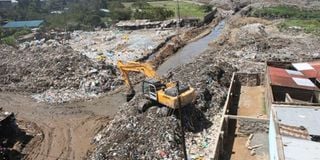Premium
The ticking time bomb that is Dandora dumpsite

An aerial view of John Osogo road in Dandora. PHOTO | FILE | NATION MEDIA GROUP
Heaps of garbage go as far as the eye can see in this part of Nairobi. A pungent smell welcomes you to the area. This is Dandora dumpsite, which is the country’s biggest garbage disposal point. Known as “boma” by residents, the dumpsite has become home to an estimated 3,000 people in the area. Boma means homestead in Kiswahili.
When HealthyNation visits the area, we find Doreen Mueni, a former scavenger at Boma, outside her house. She was rescued from the dumpsite last year.
Seventeen-year-old Doreen dropped out of school at Class Eight in 2017 for lack of school fees and went to boma as a scavenger so as to help her mother get some income.
Born in a family of six children and the odds stacked against her, she had been at the dumpsite for two years before she was rescued by a social worker and taken to the Dandora Dumpsite Rehabilitation Group (Dadreg). Doreen got a fresh start and has since enrolled for a hairdressing course.
But, she is still haunted by painful memories. Doreen watched as her mother went down with an ailment she believed was malaria. “For two weeks, my mother could not get out of the house and was depending on me to get food,” she recalls.
Her aunt, who was a scavenger, also developed chest problems.
CHILDREN NOT SPARED
Like hundreds of foragers at the dumpsite, Doreen used to collect food for pigs, plastics and gunny bags and would sell these. She did this despite the smell at the dumpsite being unbearable. “I could not go there for two consecutive days because of the strong smell. I would use a handkerchief to cover my nose,” says the teenager.

Nancy Wanjiku, who moved out of the dumpsite after she contracted TB. PHOTO | BERNADINE MUTANU | NATION MEDIA GROUP
The pungent odour, smelled from kilometers away, has made things hard for the residents of Dandora, Baba Ndogo and Kariobangi.
The dumpsite, which was declared full in 1996, has brought pain and anguish.
Nancy Wanjiku had lived at the dumpsite for nine years before she moved out. “I used to live inside the dumpsite with my children. The environment was not good for them. There are so many diseases one is exposed to at the dumpsite. It is a health hazard to the children,” she says.
Apart from the toxic fumes scavengers are exposed to, rape cases and drug trafficking have been reported. Children are not spared either as they fail to attend school so as to work as scavengers.
Wanjiku says she contracted tuberculosis while living in the dumpsite. She would cook using plastics from waste disposed of by industries which make slippers in the area. Wanjiku, also a beneficiary of Dadreg, says she was used to the smell. “Since we moved, my children are now sleeping well,” adds the mother of eight.
For four years, Hadija Issa, 42, was scavenger. She suspects the allergy she suffers from was triggered by the dumpsite. “My chest is always congested and it becomes worse when it gets cold, especially in the morning,” says the mother of five. Her children are suffering from the same problem.
HOUSEFLIES EVERYWHERE
Children are the most affected. HealthyNation visited Wangu Primary School, one of the more than 10 schools around the dumpsite. The school is a top performer in Njiru sub-County. As soon as you get into the compound, you are welcomed by houseflies everywhere.
Sometimes the stench from the dumpsite is so much that teachers are forced to release some pupils home early, said a teacher who requested anonymity because they are not authorised to speak to the press.
According to the school’s board chairperson George Onyango, they have about 2,900 pupils. The dumpsite does not make things easy for the congested school. Every class has at least 110 pupils and their worry is that an outbreak of any infectious disease would be catastrophic, says Onyango.
It is one of the public schools in the area, which partners with Dadreg to rehabilitate children living in the dumpsite. “How the children survive in the dumpsite is a miracle,” says James Alaman, the administrator and campaigns manager of Life and Dignity Programme at the Dandora Community Justice Center. “I know there are high levels of lead in the air.”
LEAD POISONING
His remarks on lead pollution is corroborated by Joe Vaughn, the administrator of Bro Andre Medical Centre in Dandora.
Health experts in the area say the upper respiratory tract infections they have been treating for years are consistent with exposure to toxic fumes.

Emily Achieng, who still scavenges at the dumpsite. PHOTO | BERNADINE MUTANU | NATION MEDIA GROUP
A 2007 research by Njoroge Kimani and United Nations Environment Programme (Unep) on the effects of the dumpsite established that “50 per cent of the children had blood lead levels above 10 micrograms per deciliter, indicating exposure to high levels of environmental lead”.
The World Health Organization (WHO) says: “At high levels of exposure (on children), lead attacks the brain and central nervous system to cause coma, convulsions and even death. Children who survive severe lead poisoning may be left with mental retardation and behavioural disorders.”
The Unep research found that the blood system of most of the children in the area was suppressed, with 12.5 per cent having blood levels below the normal range.
“Some children suffer from dizziness. I feel sad because when they grow up, they will still have health problems,” says Mary Kariuki, a health professional and director of Samaritan Medical Centre in Dandora Phase V.
Children also suffer from skin rashes, throat and eye infections, which health experts believe are due to burning of toxic waste at the dumpsite.
CANCER RISK
Air pollution has been associated with childhood cancers and cognitive impairment in both children and adults. Onyango has been working with the dumpsite community for the last eight years and suspects three women, who died of cancer, could have been exposed to pollution.
The Unep research also found mercury, another heavy metal, at the dumpsite. “Acute exposures to high levels of mercury cause nausea, anorexia, vomiting gastrointestinal abnormalities and dermatitis,” says the report.
Joy Ndege has been a resident of Dandora for the past 10 years and she feels the pollution has only worsened. “When you wake up in the morning, you see clouds of smoke which make visibility very poor. Sometimes you can feel the air is very heavy when you breathe,” says the administrative assistant at Bro Andre Medical Centre.

Apartments near the Dandora dumpsite in Nairobi on June 28. PHOTO | DENNIS ONSONGO | NATION MEDIA GROUP
HealthyNation also visited three health facilities in Dandora and in all these, respiratory infections formed the bulk of all hospital visits and hospitalisations.
At Bro Andre Medical Centre, respiratory infections and chest problems form 90 per cent of all the admissions, says Vaughn. “The respiratory infections are very many here. When we used to have the National Hospital Insurance Fund (NHIF) cover, we would treat 100 to 120 respiratory infection cases in a month,” says Ebbi Maresi, the supervisor at Samaritan Medical Centre.
But, since the withdrawal of NHIF from the hospital, they have been treating 40 to 50 patients of the infections every month. “I have been treating chest problems, pneumonia, headache and miscarriages. There are so many cases from Phase III and IV. We believe these cases are as a result of the toxic fumes from the dumpsite,” says Kariuki, a director at the hospital.
MEDICAL WASTE
At Provide International Health Care, respiratory infections are the most treated ailments. Joshua Munga, a clinical officer at the hospital, says: “They account for 50 per cent of all ailments treated at the hospital.”
Dandora has more than 10 health facilities, including two government sponsored ones and a chemist every few steps.
But, others feel the dumpsite is a blessing and the benefits outweigh the risks. Emily Achieng, a resident of Dandora Phase IV who lives right next to the dumpsite, says the sharp smell from chemicals and decomposing waste do not worry her.
She has been a scavenger for the past 13 years. She will continue doing it because that is her only source of income, she vows.
A research conducted among scavengers at the dumpsite by the African Population and Health Research Center (APHRC) in 2019 states: “A total of 45 per cent of respondents said they had experienced chest problems, 14 per cent reported asthma, 14 per cent reported tuberculosis and nine per cent reported respiratory infections. These perceptions could be based on the fact that the dumpsite is always burning, often releasing fumes that are harmful, but also the knowledge that some of the waste is from medical facilities.”
And data obtained by Unep from the Catholic Church dispensary at Kariobangi between 2003 and 2006 shows that at least 9,121 people per year “had been treated for respiratory tract related problems at the centre”.
CREATE JOBS
While it is obvious that chest problems are many around the dumpsite, there are other concerns. A study published by National Center for Biotechnology Information shows there is an association between particulate matter of less than 2.5 micrometers, nitrogen dioxide and ozone with erectile dysfunction, especially in older men.
In another study done in Viwandani and Korogocho, APHRC says: “The average levels of fine particulate matter within households are approximately 76 micrograms per cubic metre, which is over three times more than the WHO recommended maximum level.”
Generally, in Nairobi, the level of fine particulate matter in the outdoors is 17 micrograms per cubic metre, which is 70 per cent above the recommended maximum level, states WHO.
According to the Environment ministry, over five million Kenyans living in cities and towns are directly exposed to toxic emissions “from vehicles, industries, traditional fuel and kerosene used for cooking and heating and indiscriminate burning of solid waste”.
Dr Kanyiva Muindi, a researcher at APHRC, says an estimated 21,000 Kenyans lose their lives each year due to illnesses attributable to air pollution, and many others continue to battle ill health due to exposure to air pollution. “We are, however, all exposed to air pollution both in our homes, offices and outdoors,” she adds.
According to her, levels of pollution are not uniformly distributed in any given area and, therefore, some neighbourhoods face higher pollutant levels due to, for instance, their proximity to sources of emissions such as industries, dumpsites and busy roads.
Unep identified Koriokor Market, Baba Dogo and Donholm as some of the air pollution black spots in Nairobi.
Despite all the health challenges from the dumpsite, relocating it cannot solve the problem, says Alaman. “It will be transferring problems elsewhere. Can’t the dumpsite be converted to an energy source and create employment?” he posed.
According to him, lack of political goodwill is hindering proper management of the dumpsite.



